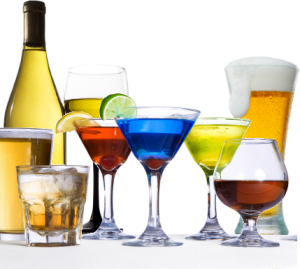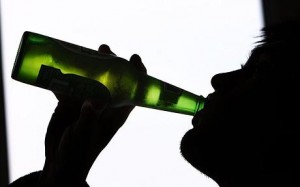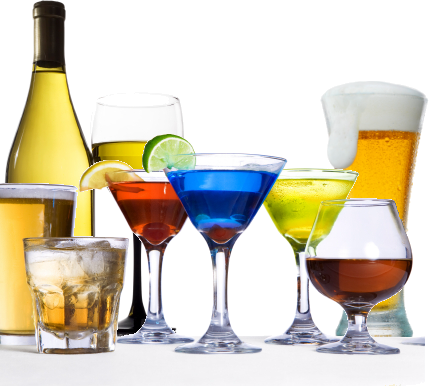 A study showed that alcoholic men who went to Alcoholics Anonymous became 9 times more likely to subsequently “binge drink” than those who used a cognitive behavioral approach. What’s more, they were also 5 times more likely to binge than a control group who received no help with drinking. The take-home message here is: you’re probably better off learning a cognitive behavioral approach for addressing substance use problems, or you might be better off getting no help at all* – than you would be going to AA for help with drinking!
A study showed that alcoholic men who went to Alcoholics Anonymous became 9 times more likely to subsequently “binge drink” than those who used a cognitive behavioral approach. What’s more, they were also 5 times more likely to binge than a control group who received no help with drinking. The take-home message here is: you’re probably better off learning a cognitive behavioral approach for addressing substance use problems, or you might be better off getting no help at all* – than you would be going to AA for help with drinking!
The study in question was called the Self Help Alcoholism Research Project (SHARP), and it was done over 30 years ago, in the mid 70’s. The results were reported in an extensive book entitled Outpatient Treatment Of Alcoholism by Jeffrey Brandsma, published in 1980. SHARP isn’t perfect and can’t tell us everything we need to know about helping people with substance use problems, but it has some features which make it a far more valuable study than many others in the addiction field – it used a control group, and follow up interviews up to a full year post treatment [a rarity in most addiction treatment research].
Is AA really harmful to your health? If so, why?
SHARP gathered hundreds of men with alcohol use problems, mostly through court referrals/mandates, and also through self referral and referral from providers of other social services. They then randomly assigned each of these men to one of five different conditions. A comparison of 3 of those conditions** leads us to the conclusion that AA can lead to increased binge drinking:
- Lay-RBT – a cognitive behavioral form of self-help sessions led by a nonprofessional ex drug abuser who had been previously helped with professionally led RBT himself
- Alcoholics Anonymous – the well known self-help group
- No Treatment – a control group who received no help of any kind
The subjects in each group had about a year (46 weeks) and between 10-30 sessions of the randomly assigned “treatment” (except of course the control group, which had no sessions. They were then interviewed at 3 month intervals for a year following the initial treatment period.
The significant differences among groups at outcome (the end of the 46 week period) were thus:
- Only 31.6% of those assigned to AA attended enough sessions to qualify to be included in the outcome measures – i.e., they dropped out – which isn’t surprising today with the knowledge that more than half of those who attend AA drop out within 3 months, and fully 95% drop out within a year. Retention rates aren’t everything, but AA has a horrific one. Meanwhile, nearly 60% of those assigned to Lay-RBT qualified for outcome measure – i.e. they continued attending a decent amount of sessions. If you think you have a helpful solution for substance use problems, you need to keep people interested in it long enough to derive what benefits are available – and if Cognitive Behavioral approaches are helpful, then with a retention rate nearly twice that of AA, they have the potential to help far more people. AA is simply abrasive, and drives most people away.
- The Lay RBT group had significantly fewer arrests and convictions than the AA group and control group.
- All groups had a nearly equal rate of abstinence at outcome – but for those who were drinking, both treatment groups were drinking less per day when drinking.
The mean number of reported binges was significantly greater for the AA group (2.37 in past 3 months) in contrast to both the control (0.56) and Lay-RBT group (0.26). In this analysis AA was five times more likely to binge than the control and nine times more likely than the Lay-RBT. The AA group average was 2.4 binges in the last 3 months since outcome. [my emphasis added- SS]
 This increased binge rate among those in AA really is a drastic difference, but to those of us familiar with the recovery culture, it makes perfect sense – we’ve seen it happen again and again – and it also makes perfect sense that those exposed to Lay-RBT or no recovery help at all would have such lower rates of binging. Let’s compare the 2 methods used here to understand why.
This increased binge rate among those in AA really is a drastic difference, but to those of us familiar with the recovery culture, it makes perfect sense – we’ve seen it happen again and again – and it also makes perfect sense that those exposed to Lay-RBT or no recovery help at all would have such lower rates of binging. Let’s compare the 2 methods used here to understand why.The Cognitive Behavioral approach used in the study (Lay-RBT) rests on some drastically different assumptions than conventional treatment and 12-step approaches according to the authors. Here are a few key examples:
Disorders of the emotions and overt behavior are the result- not the cause- of irrational thinking.
The individual is responsible in the sense that he is producing his thoughts and his behaviors, and hence he and he alone can change them.
A person can literally “think what he wants to think.” He can decide to discontinue a train of thought [craving]; he does not have to think a certain way just because he has always thought that way. Nor does he have to behave the way he has long behaved. It is precisely at the highest cognitive level- where we make the decision about what we want to think and therefore how we want to feel- that we possess the most leverage for emotive and behavioral [drinking] change. [pages 27-29]
The goal then becomes to show someone how to deliberately think for themselves, more rationally – and this will help them to help themselves overcome emotional and behavioral problems, by their own power. Summing up – this cognitive behavioral approach assumes that all people are in charge of both their emotions and behaviors directly at the level of freely chosen thoughts.
This is drastically different than common treatment approaches which assume that problematic emotional states and behaviors are driven by a mysterious disease, environmental factors, brain chemistry, genes – and in the case of 12-step – a spiritual deficiency. On the contrary to CB approaches, 12-step based treatment teaches people that they are powerless to change themselves, and that only by the grace of god, with daily support and reliance upon treatment, 12 step meetings, and sponsors, can the troubled person hope to remain free of substance use. What’s more, they’re taught that outside factors known as “triggers” will cause them to use substances.
Perhaps most importantly to the point of today’s topic – standard 12-step based treatment teaches people that they have no control over alcohol use, that their ‘disease’ is progressively getting worse (whether or not they’re currently drinking), and that a single whiff or sip of alcohol will send them on an uncontrollable rampage of drinking. It is commonly said within the recovery culture that if you start drinking again after a period of abstinence, you will go right back to your most extreme levels of drinking, and then quickly go far beyond that. In stark contrast to the foundations of cognitive behavioral approaches, the purveyors of conventional treatment and average 12-step members alike, violently oppose any suggestion that problematic substance use is a freely chosen behavior.
As a logical conclusion of the belief that problem drinkers are not in control of their drinking, AA also teaches an all or nothing view of alcohol use which surely contributes to the binge drinking phenomenon. They say that moderation is essentially impossible, and attack anyone who claims it is possible – as being dangerous (and responsible for the death of problem drinkers). The authors of the study point this out as a potential problematic issue:
The 3-month follow-up indicated that AA members had increased their binges and more often drank in order to feel superior. Perhaps the philosophy of total abstinence did not work well for these men – perhaps it led to depression and a tendency to go from one extreme to the other.
The Bottom Line
The bottom line is, AA (and the entire recovery culture) paints a grim picture of habit change, and in fact teaches people they’re incapable of it. The CB approach mentioned above paints a more hopeful self-empowered picture of personal change. People then tend to live up to the beliefs they take on as a consequence of exposure to these views – uncontrollably binging in the case of exposure to AA.
To anyone who’s read research about locus of control, this also shouldn’t be surprising. Those with an internal locus of control fare far better on any number of life quality measures from experiencing happier marriages to higher incomes – than those with an external locus of control. The recovery culture instills a decidedly external locus of control (“admit you’re powerless over alcohol”, “let go and let god”, reliance upon sponsors and meetings, fear of “triggers”), while cognitive behavioral approaches instill a decidedly internal locus of control. Think twice before you send your loved one to an AA meeting or conventional treatment program.
* Although this discussion is based on a comparison of two diametrically opposed models of self-help (12-step and and Cognitive Behavioral) and a control group, I still say you might be better off getting “no help at all” because even the professional “help” commonly available for addiction is almost guaranteed to include 12-step elements and rests on premises inherent to 12-step, and clearly at odds with cognitive behavioral approaches.
** 2 of those conditions were left out of this analysis because they were therapies provided by therapists (RBT and Insight Therapy) – as opposed to self-help methods. As the authors noted “These three groups were chosen out of the larger research project mainly because of the important empirical questions that would be addressed. Beyond this, the greater similarity of these groups might have decreased the variance problems encountered in statistical analysis of all five groups.”
SOURCE: Outpatient Treatment of Alcoholism, A Review and Comparative Study. Jeffrey M Brandsma Ph.D., University Park Press, Baltimore, 1980

158 comments
Comments are closed.